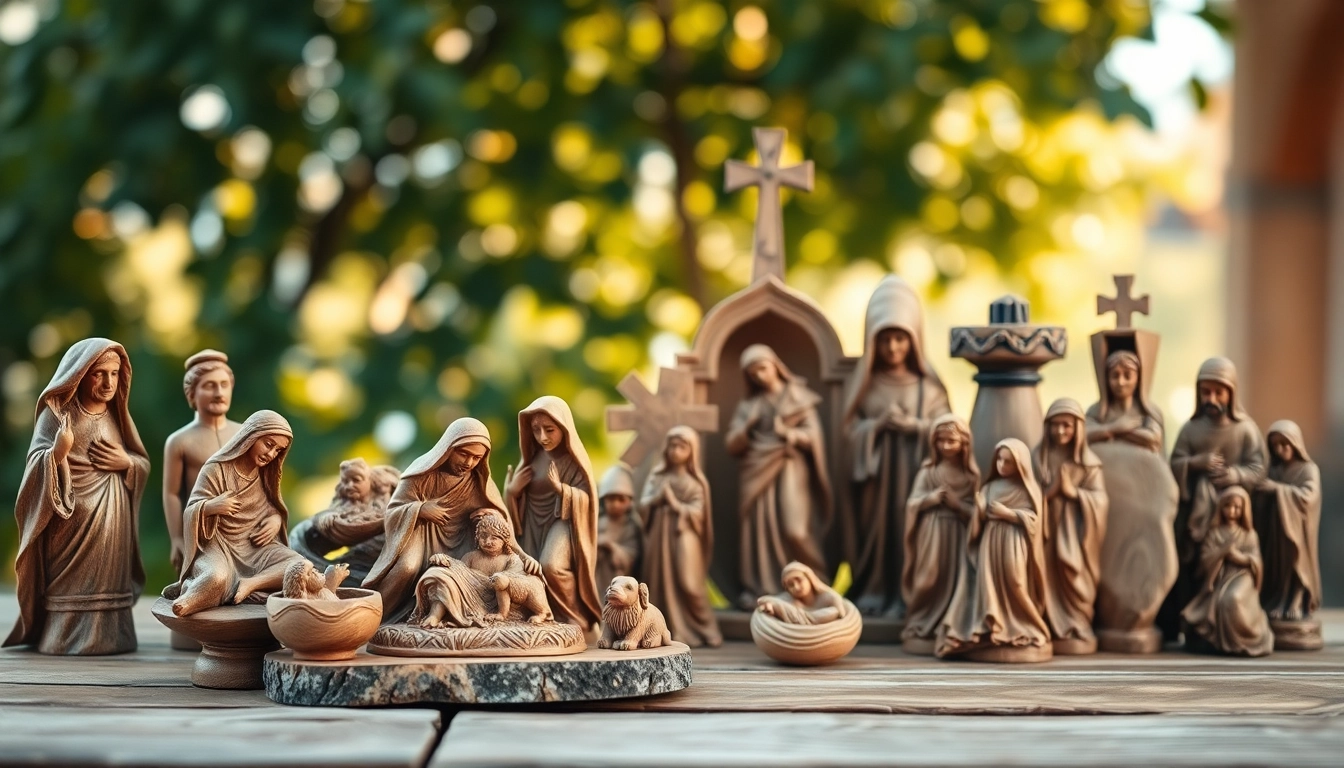The Art of Olive wood carvings
Olive wood carvings are not just artifacts; they are representations of a rich cultural heritage filled with history, artistry, and spiritual significance. Made from the wood of olive trees, these carvings have been part of the Mediterranean art scene for centuries, especially in regions like Bethlehem and Jerusalem. They embody craftsmanship passed down through generations and are cherished both as artistic creations and religious icons. Olive wood carvings have become synonymous with both beauty and devotion, making them sought after by collectors and spiritual believers alike.
1.1 History and Tradition
The tradition of olive wood carving dates back to the early centuries, with roots deeply planted in the biblical history of Palestine. The olive tree itself holds significant importance in Biblical texts, symbolizing peace and prosperity, which adds layers to the cultural essence of these carvings. Historically, artisans practiced their skills in small workshops, where they would pass down techniques and stories that narrated the rich tapestry of their heritage. These intricate carvings are often inspired by religious themes, illustrating scenes from the Bible, saints, and cultural stories that resonate within local communities.
1.2 Craftsmanship Techniques
The craftsmanship of olive wood carvings is both a technical and artistic endeavor. Artisans employ traditional techniques, often using hand tools such as chisels and knives, to carve intricate designs from blocks of olive wood. The grain of the wood, with its unique patterns and textures, is lovingly revealed as layers are skillfully removed. Experienced carvers exhibit a deep understanding of wood properties and grain direction, allowing them to optimize their designs while preserving the natural beauty of the wood. Each piece can take hours or even days to carve, embodying the artisan’s skill and devotion to their craft.
1.3 Cultural Significance
Olive wood carvings serve as more than just decorative items; they hold profound cultural and spiritual significance. In many Christian communities, they are used as religious artifacts for prayer, meditation, and as symbols of faith. Additionally, such carvings often play a crucial role in celebrations and sacred ceremonies, connecting practitioners to their spiritual roots. Beyond religious contexts, they have also become valued items in art collections, recognized for their aesthetic beauty and cultural narratives.
Popular Types of Olive wood carvings
2.1 Figurines and Statues
Figurines and statues are among the most popular forms of olive wood carvings. These pieces often depict biblical figures and scenes, such as the Nativity, the Last Supper, and various saints. Carving these intricate figures requires exceptional artistic ability and attention to detail. Each piece captures a moment or a story, inviting observers to engage with its significance. Collectors often look for unique characteristics in figurines, such as expressions and postures that convey emotion, making each one a unique work of art.
2.2 Religious Carvings
The religious significance of olive wood carvings cannot be overstated. Many artisans create crosses, icons, and other religious symbols, often with the intent of deepening the spiritual experience of the user. These carvings are frequently used in homes, churches, and places of worship, serving as constant reminders of faith and devotion. Moreover, these items are often gifted to commemorate special occasions such as baptisms, confirmations, and weddings, reinforcing their significance in religious traditions.
2.3 Decorative Items
In addition to figurines and religious items, olive wood is sculpted into various decorative pieces, including bowls, trays, and wall hangings. These items are prized not only for their beauty but also for their functionality. The natural oil present in olive wood makes it durable and resistant to moisture, thus enhancing its viability in household decor. Artisans may combine traditional carving techniques with modern designs, giving rise to unique creations that fit contemporary aesthetics while maintaining a connection to their ancient roots.
Where to Buy Authentic Olive wood carvings
3.1 Online Platforms
With the rise of online shopping, authentic olive wood carvings are now accessible to a global audience. Numerous online platforms specialize in selling handcrafted pieces directly from artisans in the Holy Land. When purchasing, it’s essential to ensure that the items are ethically sourced and crafted by skilled artisans. Reputable online shops often provide detailed descriptions and background on the craftsmanship involved. Additionally, many platforms offer customer reviews, which can guide potential buyers in their decision-making process.
3.2 Artisan Markets
Visiting artisan markets is an excellent way to purchase olive wood carvings while supporting local artisans directly. Markets in Bethlehem and Jerusalem are renowned for their vibrant displays of handmade crafts. Buying directly from artisans allows customers to appreciate the craftsmanship and individuality of each piece and engage in conversations about the art and traditions surrounding olive wood carving.
3.3 Local Shops and Galleries
Local shops and galleries that focus on handmade or cultural goods can also be a great resource for discovering quality olive wood carvings. These establishments may carry a curated selection of pieces, ensuring that they meet high standards for quality and authenticity. Additionally, local galleries may host rotating exhibitions featuring the work of various artisans, providing opportunities to learn more about the craft and its significance.
Care and Maintenance of Olive wood carvings
4.1 Cleaning Techniques
Maintaining the beauty of olive wood carvings requires proper care. Regular dusting with a soft, dry cloth is essential to prevent the buildup of dirt or grime. For deeper cleaning, a damp cloth can be used sparingly, ensuring that excess moisture does not damage the wood. It’s important to avoid abrasive cleaners or soaking the carvings in water, as this can lead to cracking or warping.
4.2 Storage Recommendations
When storing olive wood carvings, it is important to keep them away from direct sunlight and excessive humidity. Exposure to elements can lead to fading and cracking. Ideally, carvings should be stored in a climate-controlled environment where temperature and humidity are maintained. For occasional use items, using display cases can also enhance their visibility while protecting them from dust and physical damage.
4.3 Preserving Quality Over Time
To preserve the quality of olive wood carvings, applying a food-safe mineral oil can help maintain the wood’s natural luster and prevent it from drying out. This treatment can be done every few months, depending on the item’s usage and the environment it is in. Artisan craftsmanship involves not just the initial creation but also ongoing care that keeps these pieces vibrant for years to come.
Benefits of Owning Olive wood carvings
5.1 Enhancing Aesthetic Appeal
Olive wood carvings add a unique aesthetic appeal to any space. Their natural hues and stunning grain patterns can complement various decorative styles, from rustic to contemporary. Each carving is distinctive, often sparking conversations and admiration from guests. Whether displayed on shelves, used as functional decor, or utilized in religious contexts, these carvings create a warm and inviting atmosphere.
5.2 Spiritual and Emotional Value
Many find emotional and spiritual connection through olive wood carvings. Pieces can serve as focal points for meditation or prayer, anchoring moments of reflection and connection to faith. Furthermore, they often embody personal stories and heritage, making them meaningful additions to homes. For those who gift them, these carvings represent love and shared values, enhancing their emotional resonance.
5.3 Supporting Artisans and Communities
Purchasing olive wood carvings supports artisans and their communities, fostering the continuation of this cherished craft. Many artisans rely on the income generated from these sales to support their families and sustain their cultural practices. By buying olive wood carvings, collectors not only own art pieces but also partake in preservation efforts of a time-honored tradition, reinforcing the cultural heritage that thrives in these communities.



